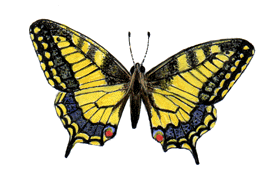The Swallowtail Butterfly
 The beautiful, creamy-yellow and black swallowtail is Britain’s most exotic butterfly but it has become increasingly rare since the 19th century. For a long time it has been confined to parts of East Anglia where its only food plant, milk parsley, flourishes. The butterfly’s favourite habitat is wetland, such as the moist bog and fen found in eastern England. The swallowtail is common throughout the rest of Europe, Africa and Asia, but the British swallowtail britannicus is a unique subspecies found nowhere else in the world.
The beautiful, creamy-yellow and black swallowtail is Britain’s most exotic butterfly but it has become increasingly rare since the 19th century. For a long time it has been confined to parts of East Anglia where its only food plant, milk parsley, flourishes. The butterfly’s favourite habitat is wetland, such as the moist bog and fen found in eastern England. The swallowtail is common throughout the rest of Europe, Africa and Asia, but the British swallowtail britannicus is a unique subspecies found nowhere else in the world.
Reasons for decline - the swallowtail and the milk parsley thrived for thousands of years in the wetlands of eastern England, but from the 18th century onwards this important habitat has been slowly but surely drained and replaced by wheat fields. The moisture-loving milk parsley has died out in many areas and the swallowtail, relying exclusively on this plant, has disappeared along with it.
The future - despite several attempts over the past forty years to increase the butterfly’s range and population, the swallowtail is still very rare. As a result of research carried out during these attempts, it has been discovered that it is essential that the ground is kept very moist to keep both milk parsley and butterfly alive.
Wicken Fen, near Cambridge, was another stronghold until the early 1950s when all the swallowtails disappeared. After many failures to reintroduce them, it was eventually discovered that the peaty soil had been slowly drying out because all the surrounding fens had been drained and led to a drop in the water table level.
Current populations in the east, at present it can only be found in the Norfolk Broads, are considered stable but this is reliant on continous management of their habitat.
Read More: Lady's Slipper Orchid